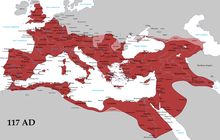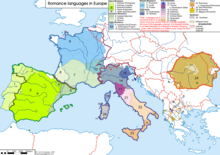Latin
Latin is an Italic language that was developed in Ancient Rome. Short Latin texts have been found from about the 5th century BC and longer texts from about the 3rd century BC.
| Latin | |
|---|---|
| lingua latīna | |
 Latin inscription, in the Colosseum | |
| Pronunciation | [laˈtiːna] |
| Native to | |
| Ethnicity | Latins |
| Era | Vulgar Latin developed into the Romance languages, 6th to 9th centuries; the formal language continued as the scholarly lingua franca of Catholic countries and medieval Europe and as the liturgical language of the Catholic Church. |
| Latin alphabet | |
| Official status | |
Official language in | |
| Regulated by |
|
| Language codes | |
| ISO 639-1 | la |
| ISO 639-2 | lat |
| ISO 639-3 | lat |
| Glottolog | impe1234lati1261 |
| Linguasphere | 51-AAB-aa to 51-AAB-ac |
 Map indicating the greatest extent of the Roman Empire under Emperor Trojan (c. 117 AD) and the area governed by Latin speakers (dark red). Many languages other than Latin were spoken within the empire. | |
 Range of the Romance languages, the modern descendants of Latin, in Europe. | |
History
changeClassical Latin was used in the 1st century BC and was the official language of the Roman Empire. It was widely used in the western part of the Mediterranean. The Romance languages developed from its spoken informal version, called Vulgar Latin.
Latin was important to Christianity for many centuries. It is still spoken today during some religious activities. It is an official language in the Vatican, where the Pope leads the Roman Catholic Church.[2] People in the Vatican sometimes speak to one another in Latin if they have different first languages. The Mass of the Catholic Church is often done entirely in Latin. It is called is the Mass of the Roman Rite (Extraordinary Form).
Latin was once the most important language in most of Europe during the Middle Ages. It was taught in many European schools, and all universities used it as their teaching language. Latin began to lose its importance in the Reformation, but it was still often used by writers of scientific books and encyclopedias. Until around 1900, many universities accepted dissertations written in Latin.
Today
changeLatin is called a dead language because no one speaks it as a first language anymore. However, it is not an extinct language because it is still used in daily life by some people. In fact, many people still study it in school. Latin is still useful because it shows how society works. Latin makes it easier to learn the Romance languages.
Classics
changePeople still read Latin classics such as the poems of Virgil, the memoirs of Caesar and the speeches of Cicero.
Science
changeAlso, Latin is widely used as an international auxiliary language, notably in the Catholic Church and by biologists when they describe and name new species.
Medicine
changeSome terms used in medicine to name parts of the body (such as bones), and names of some diseases, are also written in Latin.
Varieties
changeThere are three types of Latin: Classical Latin, Vulgar Latin and Ecclesiastical Latin. Classical Latin was used by the educated Romans and is still studied around the world. Vulgar Latin was the more common spoken variety used by the common Romans and was learned by the peoples conquered by them. Ecclesiastical Latin is common in Italian schools and still used by the Roman Catholic Church.
Romance languages
changeAs people from other regions of Europe learned Vulgar Latin during Roman conquests, each region developed its own language, which was a simplified form of Latin. Those languages are called Romance languages and are still spoken today.
Types
changeThe five Romance languages with the largest number of speakers are Spanish, French, Portuguese, Italian and Romanian. The Romance languages are very similar to one another, and speakers of one Romance language can understand many words and sentences in both texts and spoken conversations from another Romance language. For example, speakers of Portuguese can often understand Spanish. It can be said that the Romance languages are modern dialects of Latin.
Grammar
changeLatin has a similar inflection structure to Ancient Greek but a different alphabet.
Latin has seven different noun cases: nominative, vocative, accusative, genitive, dative, ablative and locative. The vocative case is almost always the same as the nominative case. The locative usually takes the form of the dative. Only place names and some nouns have the locative case. Latin nouns are declined, or changed, according to how they are used in the sentence. A noun can be declined five different ways. These ways are called declensions. The declensions are numbered 1 to 5 (first declension, second declension etc.), each having different endings that identify the noun's declension. When a noun is declined, twelve forms are made, two for each of the noun cases (the locative is omitted).
A similar thing is done to verbs, called conjugation. When a verb is conjugated, six forms are made. There are five factors that can change a verb: person, number, tense, voice and mood. In all, there are 120 possible forms Latin verbs.
Writing
changeLatin used to be written on plates of wax. There was little space and so words were run together, with no space between words. Sometimes papyrus was used, but that was expensive. Punctuation was an ancient idea but came to Latin later.[3] Lowercase letters (small letters) are relatively-modern inventions. The Roman alphabet was derived from Etruscan . The following is the introduction to the Metamorphoses by Ovid (Book 1, lines 89–100) amd describes the Golden Age.
| Old writing | Modern writing |
|---|---|
| AVREA•PRIMA•SATA•EST•ÆTAS•QVAE•VINDICE•NVLLO SPONTE•SVA•SINE•LEGE•FIDEM•RECTVMQVE•COLEBAT |
Aurea prima sata est aetas, quae vindice nullo, sponte sua, sine lege fidem rectumque colebat. |
| English translation[4] | |
| This was the Golden Age that, without coercion, without laws, spontaneously nurtured the good and the true. There was no fear or punishment: there were no threatening words to be read, fixed in bronze, no crowd of suppliants fearing the judge’s face they lived safely without protection. No pine tree felled in the mountains had yet reached the flowing waves to travel to other lands: human beings only knew their own shores. There were no steep ditches surrounding towns, no straight war-trumpets, no coiled horns, no swords and helmets. Without the use of armies, people passed their lives in gentle peace and security. | |
Post-Roman age
changeAfter the fall of the Roman Empire, many people still used Latin. Scholars such as Thomas Aquinas, Petrarch, Erasmus, Luther, Copernicus, Descartes and Newton wrote in Latin. For example, Hugo Grotius published his De jure belli ac pacis (On the Law of War and Peace) in Latin as late as 1625, which is one of the bases of international law.
Related pages
changeReferences
change- ↑ "Schools". Britannica (1911 ed.).
- ↑ "AskGeo - Vatican City". Archived from the original on 2009-02-25. Retrieved 2009-03-04.
- ↑ The Mesha Stele or Moabite Stone is a stele set up around 840 BC by King Mesha of Moab (a kingdom in modern Jordan). The stele uses full stops.
- ↑ Kline, Anthony S. (2000). "Metamorphoses Book I (A. S. Kline's Version)". University of Virginia. Retrieved 2019-12-27.
Other websites
change- Ainsworth, Robert (1830). A new abridgment of Ainsworth's Dictionary, English and Latin, by J. Dymock.
- Post-Classical Latin (including Medieval and Neo-Latin) Archived 2011-01-13 at the Wayback Machine
- Beginners' Latin on http://www.nationalarchives.gov.uk/
- Glossarium Anglico-Latinum Archived 2012-11-13 at the Wayback Machine having many modern words
- Latin language Citizendium